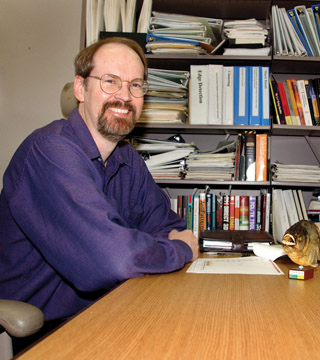
GORDON OSBOURN at the desk in his office at the time of his 2002 appointment as Sandia’s fourth Fellow. Gordon, now retired, was the first Sandian to be designated a Fellow while still an active on-roll researcher. (Photo by Randy Montoya)
In 1982, then-Sandia researcher Gordon Osbourn published a theoretical paper that asserted the previously unthinkable: that ultra-thin layers of mismatched atomic lattices could overcome the strain of their union and successfully form a defect-free bond.
Going against the grain of the times, Gordon’s calculations stimulated creation of the new field of strained-layer superlattices. Just one of the myriad results of that insight — strained-layer lasers — today dominates the entire semiconductor laser market. Approximately 1 billion are produced each year for a market valued at approximately $5 billion.
The new insights also opened a path to the high-bandwidth optical fiber network of the Internet. High-power strained-layer lasers also are used as power sources for optical amplifiers, an application that requires reliable operations for at least 25 years. Others in the cornucopia of products that emerged down the line include laser printers, DVDs, blu-ray players, certain solar photovoltaic devices, very efficient sensors and pollution monitors, optical mice, laser pointers, and the vertical-cavity surface-emitting lasers (VCSELs) used in commercial atomic clocks.
For that early work, Gordon, a retired Sandia Fellow, shared with three other scientists a portion of the 2014 Rank Prize, a major award in the field of optoelectronics. The awards are made every two years for achievements considered by a panel of prize committee members “to be of significant benefit to humanity.”
“It’s very satisfying to see just how widespread the impact of our work at Sandia has become,” emails Gordon. “Most people aren’t even aware of Sandia’s essential role in creating so many modern technologies.”
“Gordon’s prediction of the existence and power of strained-layer superlattices was transformational,” says acting Div. 7000 VP and Chief Technology Officer Julia Phillips. “His insight opened the eyes of scientists to the possibility of tailoring the properties of semiconductor devices in a way that had previously been viewed as impossible. It is hard to imagine life in the 21st century without the technologies that this discovery has enabled.”
Following in the footsteps of Gordon’s pioneering work
Semiconductor lasers are produced by the sequential deposition of nanothin layers of different materials. Their arrangement controls the optical and electrical properties of the device. Sandia, and later many other institutions, invested much effort in the study of these new structures following in the footsteps of Gordon’s pioneering work.
That is because Gordon’s paper and its follow-ons predicted a large and completely unexpected set of new semiconductor structures for possible use in device technology. The initial paper predicted not only that certain mismatched lattices would be stable but that they would have unique electrical and optical properties, contradicting the then-common scientific belief that each lattice layer should have the same or very similar crystal structure to ensure that the composite structure was not subjected to mechanical strain.
Even more remarkably, Gordon’s follow-on calculations supported the unexpected, and initially widely disbelieved, prediction that the strain itself could be used to improve the properties of devices made from these new materials.
Ripples from those initial, much-disputed papers led researchers to fabricate structures they hadn’t thought about trying, because they had been convinced the structures wouldn’t work.
(Other important applications for strained-layer materials have been developed extensively outside of Sandia that do not involve lasers at all. These include strained silicon germanium layers in microprocessor chips, and high-frequency HEMT amplifiers used in cell phones and satellite television receivers.)
In Gordon’s category for “pioneering work on strained-layer laser structures,” each of the four scientists seminal in advocating the use of strained-layers to improve semiconductor lasers was awarded £15,000 (about $25,000) in a ceremony that took place in London on Feb. 12. The other three honorees are Alf Adams of the University of Surrey, UK; Eoin O’Reilly of Tyndall National Institute, Cork, Ireland; and Eli Yablonovitch of the University of California.